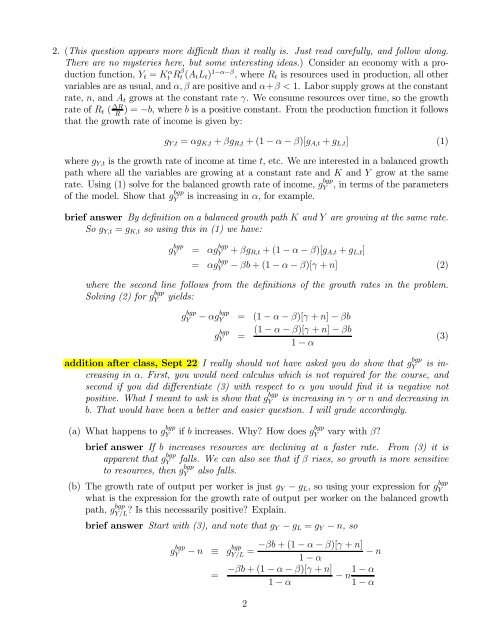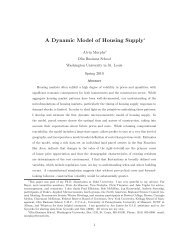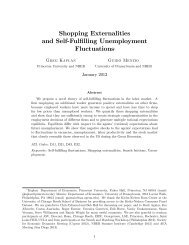Homework Assignment #1: Answer Key
Homework Assignment #1: Answer Key
Homework Assignment #1: Answer Key
Create successful ePaper yourself
Turn your PDF publications into a flip-book with our unique Google optimized e-Paper software.
2. (This question appears more difficult than it really is. Just read carefully, and follow along.<br />
There are no mysteries here, but some interesting ideas.) Consider an economy with a production<br />
function, = ( ) 1−− ,where is resources used in production, all other<br />
variables are as usual, and are positive and + 1. Labor supply grows at the constant<br />
rate, , and grows at the constant rate . We consume resources over time, so the growth<br />
rate of ( ∆ )=−, where is a positive constant. From the production function it follows<br />
<br />
that the growth rate of income is given by:<br />
= + +(1− − )[ + ] (1)<br />
where isthegrowthrateofincomeattime, etc. We are interested in a balanced growth<br />
path where all the variables are growing at a constant rate and and grow at the same<br />
rate. Using (1) solve for the balanced growth rate of income, <br />
in terms of the parameters<br />
of the model. Show that <br />
is increasing in , for example.<br />
brief answer By definition on a balanced growth path and aregrowingatthesamerate.<br />
So = so using this in (1) we have:<br />
<br />
= <br />
+ +(1− − )[ + ]<br />
= <br />
− +(1− − )[ + ] (2)<br />
where the second line follows from the definitions of the growth rates in the problem.<br />
Solving (2) for <br />
yields:<br />
<br />
<br />
− <br />
= (1− − )[ + ] − <br />
(1 − − )[ + ] − <br />
=<br />
1 − <br />
addition after class, Sept 22 I really should not have asked you do show that <br />
is increasing<br />
in First, you would need calculus which is not required for the course, and<br />
second if you did differentiate (3) with respect to you would find it is negative not<br />
positive. What I meant to ask is show that <br />
is increasing in or and decreasing in<br />
That would have been a better and easier question. I will grade accordingly.<br />
(a) What happens to <br />
<br />
if increases. Why How does <br />
vary with <br />
brief answer If increases resources are declining at a faster rate. From (3) it is<br />
apparent that <br />
falls. We can also see that if rises, so growth is more sensitive<br />
to resources, then <br />
also falls.<br />
(b) The growth rate of output per worker is just − , so using your expression for <br />
<br />
what is the expression for the growth rate of output per worker on the balanced growth<br />
path, <br />
<br />
Is this necessarily positive Explain.<br />
brief answer Start with (3), and note that − = − , so<br />
<br />
− ≡ − +(1− − )[ + ]<br />
<br />
= − <br />
1 − <br />
− +(1− − )[ + ]<br />
= − 1 − <br />
1 − <br />
1 − <br />
2<br />
(3)
















